Major corporations here and abroad are reevaluating their energy usage and looking for ways to run their facilities with green energy in an effort to save the planet.
Len Calderone for | AltEnergyMag
To create strong relations, major corporations are demonstrating that they care for the communities, in which they operate. They recognize that they have an impact on the communities and customers that they serve. They are engaging with the community to minimize the negative impact of their energy usage. At the same time, they are building and upgrading their energy infrastructure with the future in mind by lowering their carbon footprint to have clean, safe, reliable energy.
Their investments are being made not only in money, but also in the expertise and community involvement of their employees. Corporations are investing in their own onsite energy production, establishing relationships with suppliers to procure renewable energy off the grid, and reducing their energy needs. The following is what some corporations are doing to be good neighbors.
Walmart is examining every aspect of their carbon footprint as they work toward a goal of 100% renewable energy. This includes generating their own energy at their stores and facilities, reducing greenhouse gas emissions and making their private fleet of trucks more efficient.
The second highest operating expense in their stores is electricity. By adding LED lighting in their freezer cases, sales floor and parking areas, Walmart has reduced energy consumption by up to 70%.

Walmart is a leader in testing and scaling renewable energy projects in their stores, including solar, micro-wind on their parking lots, biodiesel generators and fuel cells. These locally generated power sources have the potential to meet up to 60% of a store’s energy needs.
Sorona® is a DuPont brand of fiber. It was commercialized in 2000. The fibers are claimed to be both soft and extremely stain resistant plus they have high strength for use in clothing, residential carpets, automotive fabrics and plastic parts. The renewable sourced ingredients, used to make the polymer, gives this fiber superior benefits over petroleum-based materials like nylon.

Because of end-product durability and recyclability, Sorona offers features that have the potential to reduce the environmental footprint at different stages in the life cycle of the final product. Sorona polymer production uses 30% less non-renewable energy and reduces greenhouse gas emissions by 63% compared to the production of an equal amount of nylon 6. There is potential to reduce energy consumption during fabric production because Sorona fiber extrusion occurs at lower temperatures than other synthetic fibers and can be dyed at the boiling point of water with no additional heat, pressure, or chemical carriers.
General Motors is the No. 1 automotive user of solar power in the United States. GM is committed to increase its renewable energy use to 125MW by 2020.
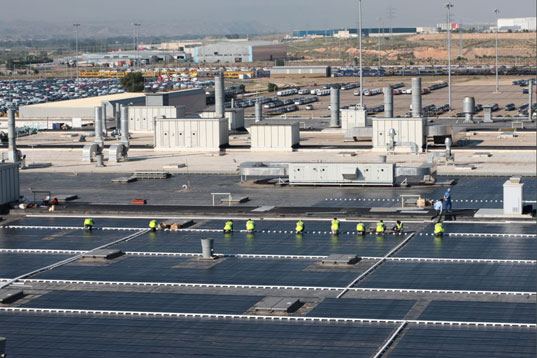
GM already owns two of the largest solar power stations in the United States, but it installed the largest rooftop solar energy system in the world at its factory in Spain. GM installed 85,000 solar panels on top of its factory, covering over 2 million square feet. The panels will provide over 10 megawatts of power to both the facility, which is responsible for over 480,000 vehicles and the local power grid.
Google has devoted over $1 billion in investments and large contracts for renewable power, Google has become the most substantial player in energy outside of the energy companies and financial institutions. The company has an ownership stake in more than 2 gigawatts of power generation capacity.
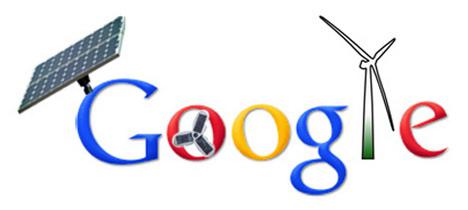
Google invested in a Texas wind farm and purchased a company that makes innovative flying wind turbines. It also invested in a solar project in California and is funding the development of an offshore grid to support wind turbines off the Atlantic coast. It also has a subsidiary, Google Energy, that sells wholesale electricity that it generates from its power assets.
In its efforts to cut its energy use, Google now uses the same amount of energy as an electric hand dryer to power 100 searches, or the same power needed for one load of laundry to enable three days of nonstop video streaming through its YouTube service. Much of the efficient Google processing power is fueled by renewable energy that Google continues to pursue.
Since its founding in 1886, Johnson & Johnson has grown to become one of the most broadly based companies in human healthcare, and the company realizes that the environment is the ultimate human health issue. J&J has set goals to augment the percentage of renewable energy and increase the energy efficiency of their facilities and transportation fleet.
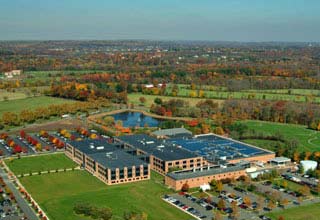
Johnson & Johnson operates in 57 countries and draws almost 30 percent of its electric power from green sources. The company is the second largest corporate user of on-site photovoltaic solar energy in the U.S, using more than two megawatts of power to operate facilities in California, New Jersey and Pennsylvania.
The Hyatt Regency Scottsdale Resort and Spa at the Gainey Ranch in Scottsdale Arizona, installed the nation’s largest solar hot water system ever built for a hotel. The solar thermal system provides domestic hot water for the guest rooms, main laundry and all of the restaurants in the 492-room resort.

The McDowell Mountains can be seen from the Hyatt Regency
The energy-reduction project designed by the Hartman Company, an engineering and design firm in Austin, Texas, will eventually reduce the Hyatt’s energy use by 50%. The solar system has a 20,000-gallon storage tank, larger than currently required, which will enable a possible Phase 2 of the project doubling the current system size. More than 156 metric tons of carbon dioxide (green house gases) will be offset by the system each year.
Both renewable and alternative energy are important parts of P&G’s (Proctor and Gamble) sustainability program. This flexibility enables them to maximize efficiency and continue to decrease their dependency on conventional petroleum-based energy sources. They are using solar energy at their facilities in Germany, Italy and the U.S., and are evaluating additional opportunities globally.
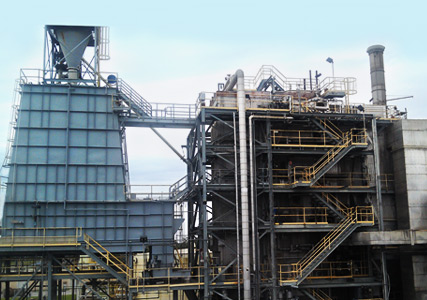
Biomass boiler
P&G’s biomass boiler in Albany, Georgia, produces steam to power their plant by using renewable resources. The boiler uses locally purchased wood, supporting local jobs and decreasing the net CO2 production that would have resulted from burning fossil fuels. The wood is delivered to the boiler where combustion takes place on vibrating grates. A Wet Electrostatic Precipitator then scrubs particulate emissions from the boiler, and its leftover ash is beneficially reused to enhance farmlands.
 Refreshments earned the No. 3 spot on the U.S. Environmental Protection Agency's list of the largest on-site green power generators. A key factor in Coca-Cola Refreshments' high ranking is the recent installation of a landfill-gas-to-energy system at one of its Atlanta facilities. The system supplies most of the facility's energy needs, including electricity, steam and chilled water. It is one of the largest biogas projects of its kind in the United States. The use of bio-fuels, fuel cells and solar panels to provide alternative energy at other facilities also contributed to the recognition.
Refreshments earned the No. 3 spot on the U.S. Environmental Protection Agency's list of the largest on-site green power generators. A key factor in Coca-Cola Refreshments' high ranking is the recent installation of a landfill-gas-to-energy system at one of its Atlanta facilities. The system supplies most of the facility's energy needs, including electricity, steam and chilled water. It is one of the largest biogas projects of its kind in the United States. The use of bio-fuels, fuel cells and solar panels to provide alternative energy at other facilities also contributed to the recognition.
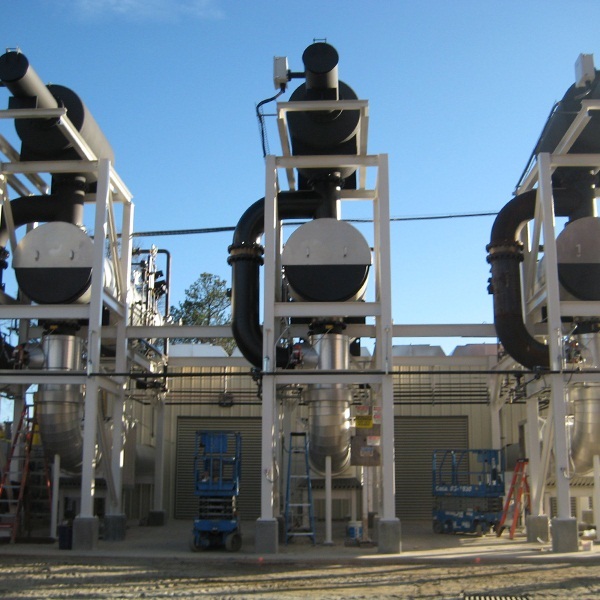
The energy plant is located adjacent to Coca-Cola’s syrup plant and supplies it with all of its electricity, steam and chilled water needs. Methane is collected at the plant and is cleaned, upgraded and delivered to the energy plant via a six-mile pipeline. Three reciprocating engines convert the gas into power, and three heat-recovery engines use heat from the reciprocating engines to produce steam. A steam turbine-driven chiller then uses that steam to produce chilled water. Coca-Cola now uses six percent renewable energy as a company, according to the EPA rankings. This percentage is greater than the top two green power users.
Major corporations here and abroad are reevaluating their energy usage and looking for ways to run their facilities with green energy in an effort to save the planet. I just touched on a few that stand out to give the reader a glimpse into what corporate leaders are doing for the environment. They are being good neighbors.
For additional information:
1. http://www.renewablechoice.com/blog-aicpa-white-paper-13-07-25.html
3. http://www.csrwire.com/renewable_energy
4. http://www.environmentalleader.com/2011/05/26/does-corporate-social-responsibility-increase-profits/
|
Len Calderone - Contributing Editor
Len has contributed articles to several publications. He also writes opinion editorials for a local newspaper. He is now retired.
|
 |
The content & opinions in this article are the author’s and do not necessarily represent the views of AltEnergyMag
Comments (0)
This post does not have any comments. Be the first to leave a comment below.
Featured Product


